Outside of Europe, students in grade school generally do not learn how to use a fountain pen.
Sadly, without that experience, most have to go out of their way to develop an appreciation for the artistic element of writing Those who have experience with fountain pens would likely agree that writing with a nib and ink is so much more unique and sophisticated than using a ballpoint pen.
In the past, we introduced the famous brand Montblanc, (see if they are worth their money here) which is recognized for its writing instruments across the world. Today, we would like to introduce to you another manufacturer of high-quality fountain pens that are not so much a status symbol, but rather offer a wide range of colours and designs: Pelikan
I want to start with a few tidbits about the history about Pelikan, a few of the brand’s iconic pens, and then continue to discuss a few current models and advise you on how you find the right nib width for your pen.
Pelikan History
In 1838, Carl Hornemann founded a factory for the newly introduced chemical dyes and inks near Hannover, Germany.While his firm Pelikan, at first specialized on art supplies for professionals only, the range of products was extended to office supplies in 1846. Literally translated, it means “pelican” but interestingly, it took until 1878 to introduce the ubiquitous Pelikan logo, which serves as the company’s logo today. At the same time, it was officially registered, which makes it one of the oldest trademarks in the world today. Throughout its history, the logo was only adapted slightly but it never deviated from the bird the provided the name.
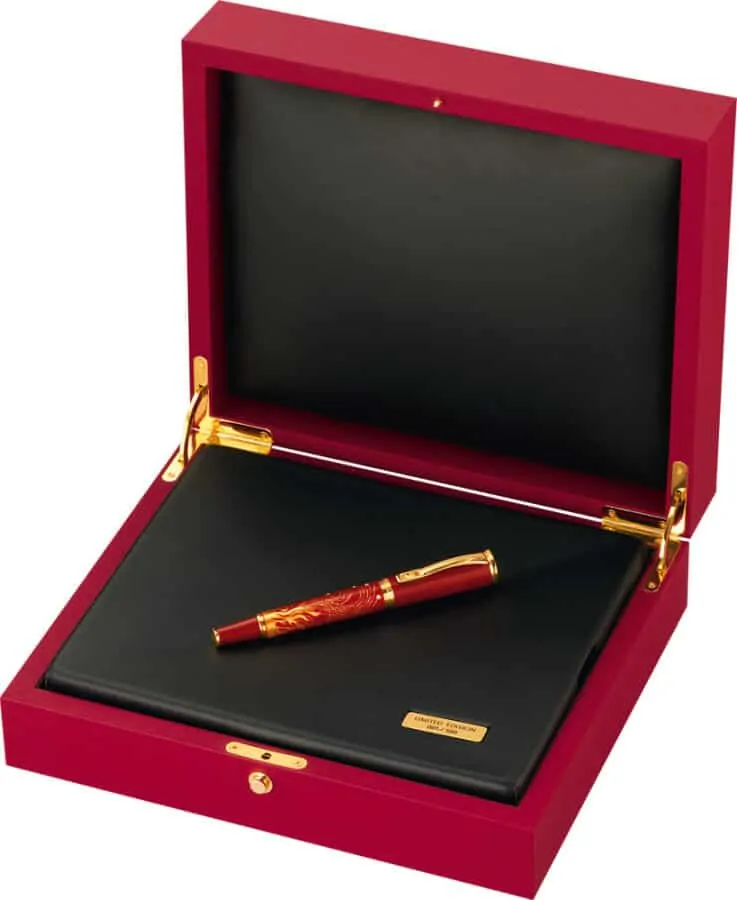
The Fountain Pen
Finally, in 1929 the first Pelikan fountain pen was introduced in Germany. By then, many other manufacturers had introduced similar pens, however it was still a difficult task to use a fountain pen. The lever pen with a hose on the inside and so called “security pens” were not secure at all and charging (filling it with ink) often resulted in color stains on the hands or pocket lining. In addition, the capacity of these writing instruments was low, and hence most people saw little benefit in turning away from writing the traditional way with a stylus and an inkwell.
Pelikan’s fountain pen was revolutionary in the sense that it had a piston mechanism that consisted of differential threads. This mechanism was invented by the Hungarian engineer Theodor Kovács and filed in 1921 and patented in 1923. Using two threads with different telescope thread leads, the piston moves much faster than with a single thread. This not only allowed for a quicker charging by simply turning a knob, but it also increased the capacity considerably. On top of that, the use of cork prevented the fountain pen from leaking. Pelikan bought the patent for this invention in 1927 from Kovács since he failed to create a working fountain pen with his Croatian business partners. Pelikan later substituted the cork with plastic as seen below, because cork dries out over time and decreases in volume, causing the fountain pen to leak.

In the early years, Montlanc and Pelikan worked very closely together, because Montblanc did not produce ink and Pelikan did not produce any nibs. In 1935, Pelikan began to produce their own fountain pens completely. Although unknown whether MB was the exclusive supplier of nibs to Günther Wagner’s company, the early Pelikan nibs are true collector’s items because of their flexibility. Softness wasn’t the only characteristic contributing to the pen’s flexibility; the writer could also create a unique look by applying a different amount of pressure, as seen here.
Despite the worldwide economic crisis of the ’30s, Pelikan prospered due to its top notch products, consumer confidence, and good marketing. The first Pelikan fountain pen was called “transparent” because it featured a little window that allowed you to check the level of ink.
Pelikan 100
The first iconic fountain pen was the Pelikan 100, which received its name in 1931 as a form of distinction, although it had been introduced before. It is a perfect example of the German Bauhaus simplicity. The shaft was made of green bakelite and the only decorative piece on the pen was the barrel cap band in gold. Subsequently, it was also available in all black but the green models are so much more interesting because the color changed over time. As such, so that there are hundreds of different green shades available today.
Pelikan Inks
Iron Gallus Permanent Ink
Being one of the major ink suppliers of Europe was a huge benefit for the Pelikan fountain pens because the customers already trusted the brand. (This so-called Halo effect is the same effect that led to roaring sales numbers of computers after Apple had become famous for the iPod music player.)
In the beginning, Pelikan focused mainly on iron gall inks. Iron gall inks discolor to a blackish shade once they dry and are permanent and water-resistant. However, usage of this kind of inks requires serious care and maintenance. Iron gall inks consist mainly of tannic acid, gallic acid (e. g. from gallnuts) and iron vitriol. Due to the fact that microscopic particles in iron gall inks lead to clogging, usage in fountain pens is somewhat problematic, if not impossible (in case one uses a converter pen, which is known for not being easily cleaned).
Iron gall inks are still available today and if you use it, should be rinsed at least twice a year, which is twice as often as with the use of normal inks.
4001 Ink
In 1898, non-iron gall inks were introduced, with the most famous of them, numbered “4001”, which is still sold today. We owe the worldwide ubiquity of the ink shade “Royal Blue” to Pelikan and it still is the gold standard of ink today.

Pelikan Fountain Pens Today
Pelikan Souverän
Being the direct successor of 1950’s Pelikan 400, the Souverän is probably one of the most iconic fountain pens today. The most eye-catching aspect is the striped shaft made from cellulose acetyl. This “pinstripe” pattern resulted in the Souverän’s nickname Stresemann – the Secretary of State in Weimar Republic well-known for his striped trousers.
The Pelikan Souverän (=sovereign) can be bought in many different colors and even a wide range of Special Editions.
| Size | 1000 | 800/805 | 600/625 | 400/405 | 300/305/320 |
|---|---|---|---|---|---|
| M 300-1000 [1] | $545 | $415 - 459 | $246 - 358 | $260 - 290 | $272 |
| M 405-605 [2] | $311 | $275 - 290 | |||
| M 625 [3] | $560- 729 | ||||
| M 320 [4] | $315 - 440 |

Souverän M 800 Italic
Fans of calligraphy normally used to consider oblique nibs. The downside of this is that the calligraphy effect normally can hardly be noticed (especially if the nib is OM or OB). Furthermore, writing with an oblique nib requires special skill, and is not recommended for the left-handed.
To fill the gap, Pelikan founded the Special Edition “Souverän M 800 Italic”. Instead of an oblique nib with the problems mentioned above, the M 800 I features a flattened IB nib. This nib has a rectangular contact surface, resulting in tremendous variations of line thickness without requiring a lot of skills. It’s somewhat “calligraphy for all of us.” I personally own this model and recommend it to anyone – except those who prefer writing thinner lines.
Pelikan Ductus
With prices of $ 350 -420 and a sleek, streamlined, puristic design, Pelikan Ductus (owner of Stylus Icon Award 2009) is the direct competitor of Montblanc’s Starwalker. It can be used with cartridges or a converter and is available in either black-silver (P 3100) or black-gold (P 3110).
Pelikan Majesty
The Majesty fountain pen is a combination of a solid sterling silver shaft with embellishments in 24-carat gold or genuine platinum. Available in gold and silver (M 7000) or black and silver (M 7005), the Majesty sells for $890 – 1320.
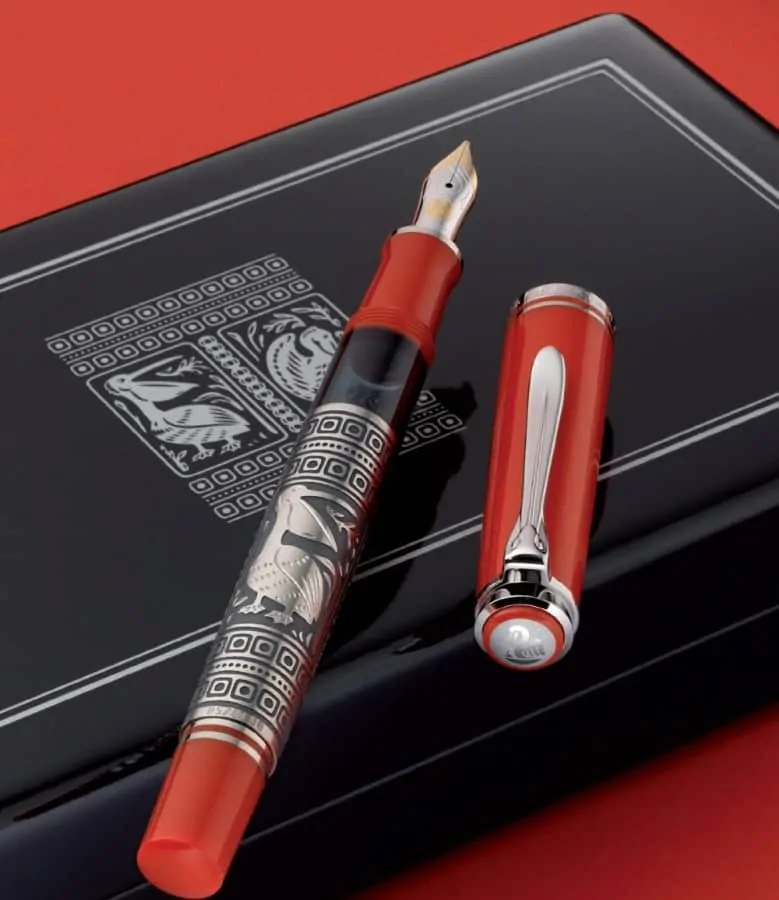
Pelikan Toledo
More than 80 years old and still popular: since 1932, the Top Ten of the most beautiful Pelikan pens always inclusded the Toledo – a fountain pen many consider the firm’s best ever. In the tradition of Spanish artists, this fountain pen is not simply “made”, but rather “damascened”. The scored base of sterling silver is covered with a thin foil of gold and then hammered until the pattern becomes three-dimensional. Most collectors consider the Toledo their most beautiful piece of art, resulting in the Toledo being a number one cash cow at auctions.
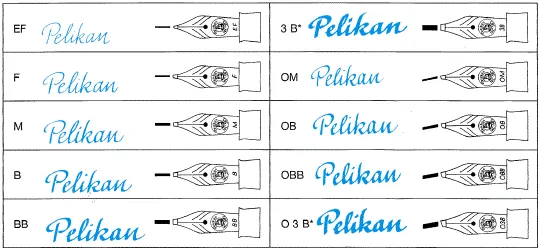
How To Choose The Proper Nib For You
Once you have settled on your favorite fountain pen design, you should think about the nib. Unlike ball point pens, the nib is of great importance and the most beautiful fountain pen might be of no use if you choose a nib that doesn’t suit your needs.
For the slim gentleman
The two thinnest nibs available are called “F” (fine) and “EF” (extra fine). I would recommend these nibs to men with small handwriting, it might look good even with bigger handwriting if your style is rounder. In case you have rougher edges in your handwriting, these nibs are probably too sharp.
The standard nib
Most nibs are M, which stands for “medium size” but bear in mind it is just related to the width and has nothing to do with quality scales.
Apart from M, “B” (broad) is the most commonly used nib because both work for almost any hand. Signatures look good with both of these nibs. If you keep a guest book at home, or you would like to give somebody a fountain pen as a gift, choose M or B so they will be able to write with it. Bear in mind though that B nibs are less adequate for people with a small, stocky handwriting.
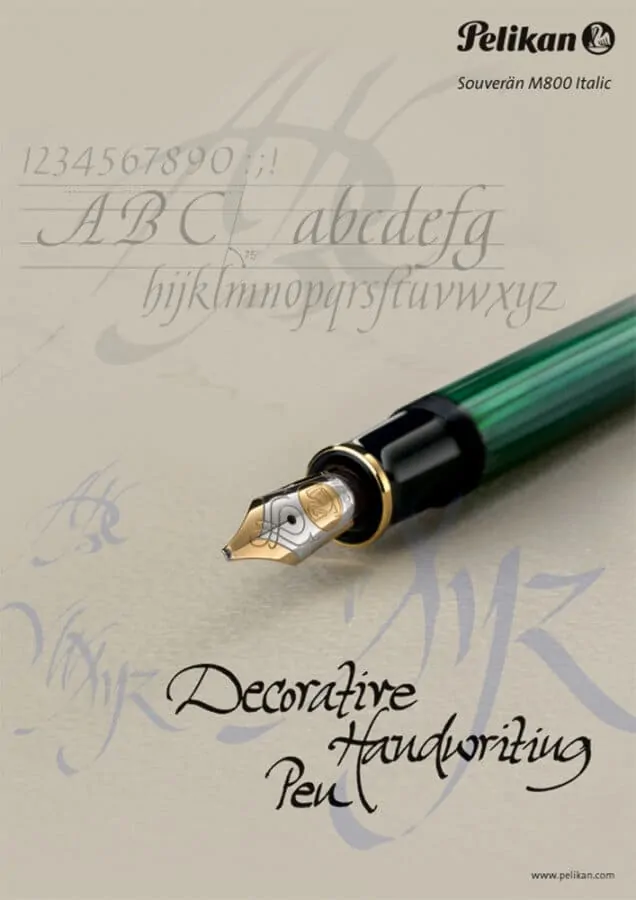
For the extrovert
If you have a large-size handwriting, go with “BB” (double broad) or even “3B” (extra broad) nib, although the latter is usually more suited to signatures. Since you will get more ink on the paper with these nibs, you have to be more careful not to wipe over with your hand. As such I would suggest to try it first if you are left handed. For signatures I recommend using an ink blotter to prevent any unwanted ink stains.
For the aesthete
Nib sizes M to 3B are also available as so-called “oblique nibs,” hence they are called “OM”, “OB”, “OBB”, and “O3B.” Those nibs are beveled on the left side. If one tilts the pen slightly to the left, the line thickness varies according to the writing direction, resulting in a calligraphy-like handwriting. The broader the nib, the stronger this effect. Oblique nibs are not recommended for beginners or left-handed people. You should always test oblique nibs before you buy them, otherwise chances are you won’t be happy.
Some calligraphists as well as stenographers swear by flexible nibs. Their two adjacent wings result in a very thin line, which however gets much broader once one writes with greater pressure (which pulls the ends of the wings away from each other). However, those pens are a rare commodity, and I only recommend to buy these from trusted dealers such as penboard because these fountain pens need more maintenance than modern-day ones.
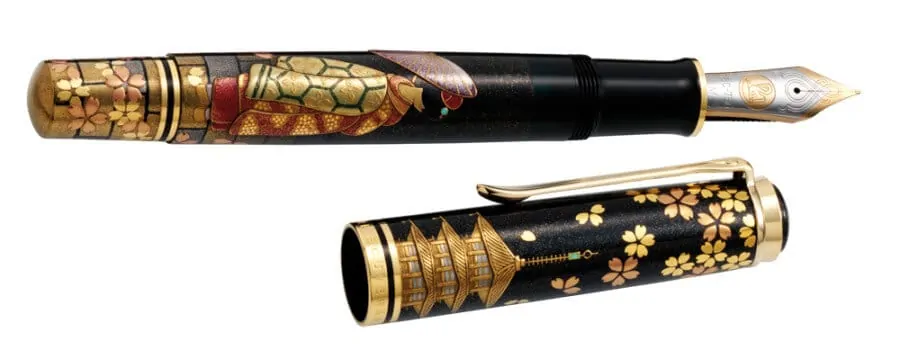
Buying the Right Fountain Pen: Dos and Don’ts
Step 1: Map the Terrain
First you should check the websites of your favorite pen manufacturer fin order to figure out what you like, maybe you even have a fountain pen store closeby, though chances are they only have a limited selection in stock. If you go to a brick & mortart business, ask a question and observe the reaction. How do they respond to you? Is a profound counseling important to the retailer, or does he or she just try to aim for a quick sale? After about three minutes, you should have some kind of a gut instinct. A fountain pen dealer should also have various nib sizes for you to test. Also bear in mind, that the width of a B nib may be different from one manufacturer to another.
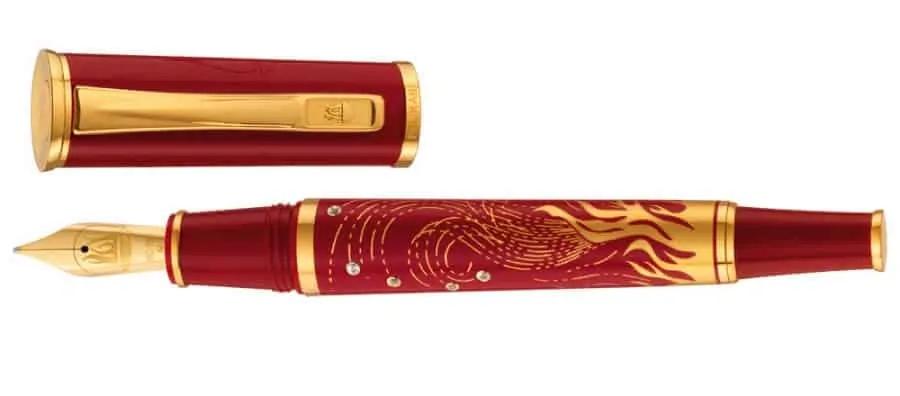
Step 2: Take Your Time
After you have decided on a fountain pen, you should try it, though some dealers/ manufacturers will exchange your nib for a certain period of time. Pay attention to the ink flow, when does it start ? Is is smooth? or is it interrupted? Does is feel soft or scratchy?
Step 3: After the Acquisition
Pelikan and other manufacturers use 14K or 18K gold nibs that are hand made. As such, every nib is different and it must be broken in to your hand. This will take a few weeks, depending on how much you write by hand, but once it is written-on, you will be able to tell the difference. However, that also means that you should not borrow the pen to anyone else because the way they write is different from yours and it may change the smoothness of your nib. Overall, a fountain pen is a much more personal writing instrument than a regular pen.
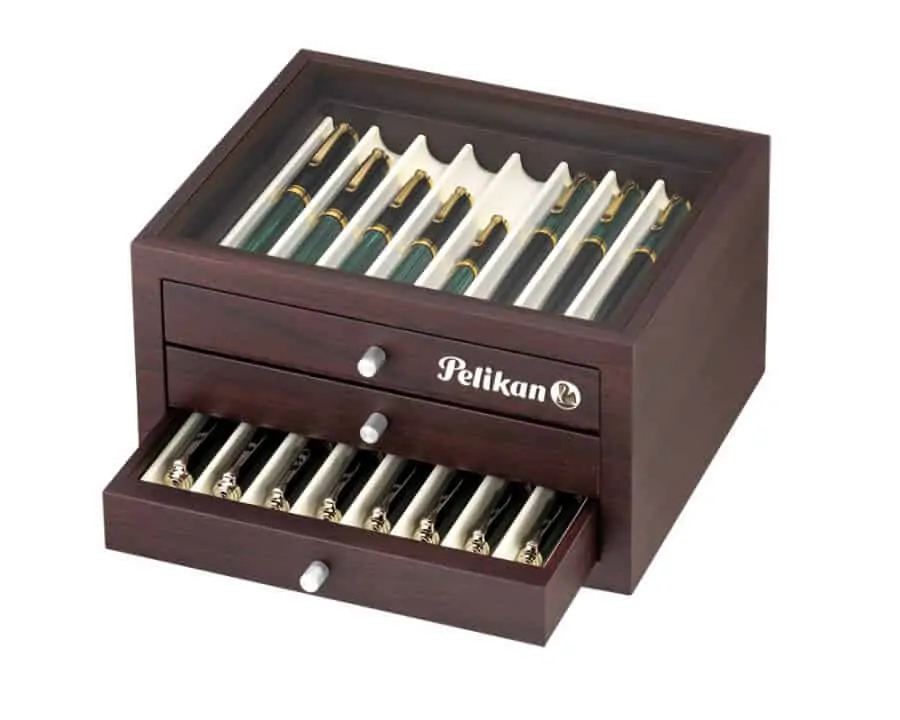
Conclusion
Without a doubt, the most well-known and maybe most important fountain pen is probably the Montblanc Meisterstück 149 . However, Pelikan provides good quality and simply beautiful products, in my opinion. Pelikan’s options, beginning with the Classic range beginning at ninety dollars up to the Limited Edition Maki-E for several thousands, provides a huge range of designs and colors and once you have found the right fountain pen, you have a companion for life.
What is your favorite fountain pen? Have you ever used Pelikan?
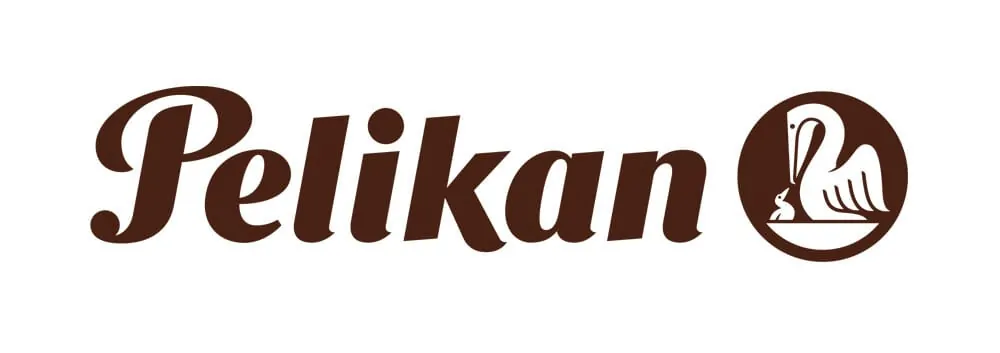
Being an anglophile society, it is mandatory at our good schools in Pakistan to nurture hand-writing through meticulous use of fountain pens.
I have the pleasure of having used Pelican pens and am delighted to say that I still employ the Pelican 4001 ink in Turquoise in my everyday use.
What a delightful article – well done. I still have the fountain pen (with my initials on it) that it was compulsory to purchase at school – it was 1968, age 7, in England and we were taught how to write with them.
I have used fountain pens ever since, and have recently started to collect vintage ones as a hobby. Nothing matches the sense of timeless ease and elegance of writing with a fountain pen.
Thank you for such a thoughtful post.
Mark
Thanks you. This is a wonderful article. It was very well written and the images were great too! I hope it reaches the wide audience it deserves.
A terrific article, which I’m sharing with my customers. Thanks so much!
Very good article. A great read.
I’m writing with fountain pens for as far as I can remember. I wrote with them throughout my school (mandatory in primary and high school) and university career and just kept using them. I still have my old Mont Blanc and Pelican pens and still use them proudly. When you want a quality fountain pen that is a little cheaper, I can recommend Diplomat (made in Germany)
Back in the 1970’s, when still relatively young, I befriended a small group of German expats who had chosen, at least for the time being, to settle in To ronto.
This group was centered around two individuals, both very pleasant: Count von Roeder, an aristocrat, and although still only in his late twenties, already well versed in the pleasantries of life and Falk Beindorph, heir to the Pelikan pen fortune.
Von Roeder, along with the young Princess von Hohenlohe, provided the raison d’etre around which the group centered; Beindorph the cash.
For several years, elegant cocktail parties and seasonal dinners were enjoyed every few months. It was an excuse for everyone to have dinner clothes made.
Falk showed me some of the pens that had been in his family for decades. All were elegant. All worked remarkably well.
Eventually the group fell apart. Some members returned to Europe. Others moved to the United States. Stiil, I have always had an appreciation for Pelikan writing instruments even though, personally, I have always favored Parker Duofold pens and pencils, of which I have about a half dozen. But, that is another story to be shared at a later time.
Good article, but the barrel of the Pelikan 100 is not Bakelite, but celluloid. Also, converter pens are just as easy to clean as piston fill or other self filling fountain pens. But the bottom line is, Pelikan pens are excellent. Thanks.
Steve, thank you for your kind words. It is my understanding that the very first Pelikan pens used bakelite barrels but they were soon switched to celluloid. Are you absolutely sure?If so, do you have a source? Thanks
Just started following your blog, you have some really interesting and informative articles on here. I’m trying to start up my own British men’s lifestyle blog, needless to say there’s lots of inspiration here!
Thanks, Charlie
Gald you like it Charlie.
Once Again Mr. Schneider you have highlighted an article that is truly dear to me in fact I have even started a collection of fountain pens and also have taken some course in the art of calligraphy.
I am thinking too about the possibility of investing in some vintage fountain pens again thank you so much on such a marvelous article with details and research information!
Dear Park Jacobs,
You should definitely try a vintage fountain pen with a flexible nib sometime, it is definitely an experience. Also, if you really like it, please share it on reddit.
Thanks!
Thanks for this fantastic overview of my favourite fountain pen brand!
You are welcome.
In general, I enjoyed the article, but I do have to take some exception to the author’s opening assertion: “Today, we would like to introduce to you another German fountain pen manufacturer that is not well known outside of Germany, yet provides quality pens that are at least as good as the MB Meisterstück: Pelikan.” On the contrary, Pelikan is very well known and respected in the United States. Although Montblanc has the high end luxury market, Pelikan and another German marque, Lamy, are among the most popular. I have examples of both in my collection which also see regular use in the rotation.
Rick Propas, the proprietor of the online PENguin, wrote a wonderful four-part Pelikan History article, which can be found at http://www.pentrace.net in the articles section.
richardspens.com not only sells Pelikan fountain pens, but also offers a full range of custom specialty nibs, including stubs, italics, obliques, and several unique nibs developed especially by Richard Binder.
David,
If you show people on the street a Montblanc pen and a Pelikan pen, which one are they going to recognize more often? I am sure it is the Montblanc with its iconic symbol. Among collecters Pelikan is of course well known. Same thing with Lamy, they provide a lot of pens of good quality, but they are not as well known as MB outside of Germany.